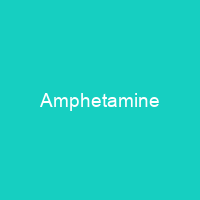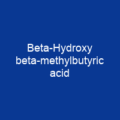Amphetamine was discovered in 1887 and exists as two enantiomers: levoamphetamine and dextroamphetamine. At therapeutic doses, amphetamine causes emotional and cognitive effects such as euphoria, change in desire for sex, increased wakefulness, and improved cognitive control. Larger doses of amphetamine may impair cognitive function and induce rapid muscle breakdown. Addiction is a serious risk with heavy recreational amphetamine use, but is unlikely to occur from long-term medical use at therapeutic doses.
About Amphetamine in brief

It is a prescription drug in many countries, and unauthorized possession and distribution are often tightly controlled due to the significant health risks associated with recreational use. The first amphetamine pharmaceutical was Benzedrine, a brand which was used to treats a variety of conditions, particularly for depression and chronic pain. Currently, pharmaceutical amphetamine is prescribed as racemic amphetamine, Adderall, dextraamphetamine, or the inactive prodrug lisdexamfetamine. It is also the parent compound of its own structural class, the substituted amphetamine, which includes prominent substances such as bupropion, cathinone, MDMA, and methamphetamine. The term is frequently used informally to refer to any combination of the enantiomer, or to either of them alone. Amphetamine increases monoamine and excitatory neurotransmission in the brain, with its most pronounced effects targeting the norepinephrine and dopamine neurotransmitter systems. It also improves function in several parts of the brain,. such as the right caudate nucleus of the basal ganglia. It can also improve reaction time, fatigue resistance, and increased muscle strength. It has been used in the past to treat nasal congestion and depression, and is sometimes prescribed off-label for its past medical indications, such as depression and Chronic pain. The drug is also used as an athletic performance enhancer and cognitive enhancer, and recreationally as an aphrodisiac and euphoriant. In the U.S. it is marketed under the brand name Evekeo, among others.
You want to know more about Amphetamine?
This page is based on the article Amphetamine published in Wikipedia (as of Nov. 16, 2020) and was automatically summarized using artificial intelligence.







